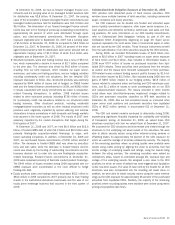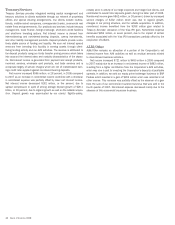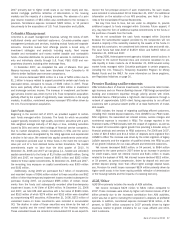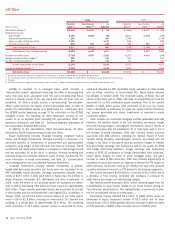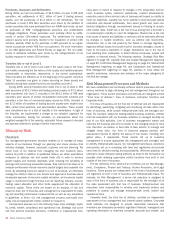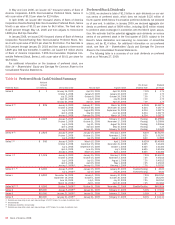Bank of America 2008 Annual Report Download - page 53
Download and view the complete annual report
Please find page 53 of the 2008 Bank of America annual report below. You can navigate through the pages in the report by either clicking on the pages listed below, or by using the keyword search tool below to find specific information within the annual report.available to cover such losses and by evaluating any estimated shortfalls
in relation to contractually defined triggers. As of December 31, 2008,
$13.1 billion of outstanding principal balances of our home equity
securitization transactions were in rapid amortization. Another $2.8 billion
of outstanding principal balances in our home equity securitization trans-
actions are expected to enter rapid amortization.
The Corporation is responsible for funding additional borrower draws
on home equity lines of credit underlying our securitization transactions.
When transactions enter rapid amortization, principal collections on
underlying loans are used to pay investor interests. This has the effect of
extending the time period for which the Corporation’s advances are out-
standing and we may not receive reimbursement for all of the funds
advanced to borrowers, as senior bondholders and monoline insurers
have priority for repayment. While the available credit line for home equity
securitization transactions in or expected to be in rapid amortization was
approximately $1.0 billion at December 31, 2008, a maximum funding
obligation attributable to rapid amortization cannot be calculated as the
borrower has the ability to pay down and redraw balances. The amount in
Table 8 equals the principal balance of the outstanding trust certificates
that are subject to rapid amortization or $13.1 billion at December 31,
2008. This amount is significantly higher than the amount we expect to
fund. The charges we will ultimately record as a result of the rapid amor-
tization events are dependent on the performance of the loans, the
amount of subsequent draws, and the timing of related cash flows. At
December 31, 2008, the reserve for losses on expected future draw obli-
gations on the home equity securitizations in or expected to be in rapid
amortization was $345 million. For additional information on home equity
securitizations, see Note 8 – Securitizations to the Consolidated Financial
Statements.
Municipal Bond Trusts
We administer municipal bond trusts that hold highly rated, long-term,
fixed-rate municipal bonds. The trusts obtain financing by issuing floating-
rate trust certificates that reprice on a weekly basis to third party invest-
ors. We serve as remarketing agent and liquidity provider for the trusts.
These trusts are discussed in more detail in Note 9 – Variable Interest
Entities to the Consolidated Financial Statements.
At December 31, 2008 and 2007, we held $688 million and $125
million of floating rate certificates issued by unconsolidated municipal
bond trusts in trading account assets. This increase is attributable to illi-
quidity in the marketplace that occurred during the second half of 2008.
Customer-Sponsored Conduits
We provide liquidity facilities to conduits that are sponsored by our cus-
tomers and which provide them with direct access to the commercial
paper market. We are typically one of several liquidity providers for a
customer’s conduit. We do not provide SBLCs or other forms of credit
enhancement to these conduits. Assets of these conduits consist primar-
ily of auto loans, student loans and credit card receivables. The liquidity
commitments benefit from structural protections which vary depending
upon the program, but given these protections, the exposures are viewed
to be of investment grade quality.
These commitments are included in Note 13 – Commitments and
Contingencies to the Consolidated Financial Statements. As we typically
provide less than 20 percent of the total liquidity commitments to these
conduits and do not provide other forms of support, we have concluded
that we do not hold a significant variable interest in the conduits and they
are not included in our discussion of VIEs in Note 9 – Variable Interest
Entities to the Consolidated Financial Statements.
Credit Card Securitizations
During the second half of 2008, we entered into a liquidity support agree-
ment related to our commercial paper program that obtains financing by
issuing tranches of commercial paper backed by credit card receivables
to third party investors from a trust sponsored by the Corporation. If cer-
tain criteria are met, such as not being able to reissue the commercial
paper due to market illiquidity, the commercial paper maturity dates can
be extended to 390 days from the original issuance date. This extension
would cause the outstanding commercial paper to convert to an interest
bearing note and subsequent credit card receivable collections would be
applied to the outstanding note balance. If any of the investor notes are
still outstanding at the end of the extended maturity period, our liquidity
commitment obligates us to purchase maturity notes in order to retire the
investor notes. As a maturity note holder, we would be entitled to the
remaining cash flows from the collateralizing credit card receivables. At
December 31, 2008 there were no maturity notes outstanding and we
held $5.0 billion of investment grade securities in AFS debt securities
issued by the trust due to illiquidity in the marketplace. For more
information on how our credit card securitizations impact our liquidity, see
the Liquidity Risk and Capital Management discussion on page 55.
Collateralized Debt Obligation Vehicles
CDO vehicles hold diversified pools of fixed income securities which they
fund by issuing multiple tranches of debt securities, including commercial
paper, and equity securities. We provided liquidity support in the form of
written put options to several CDOs totaling $542 million and $10.0 bil-
lion at December 31, 2008 and 2007. In addition, we provided other liq-
uidity support to a CDO conduit of $2.3 billion at December 31, 2007.
These CDOs are discussed in more detail in Note 9 – Variable Interest
Entities to the Consolidated Financial Statements.
The decrease in liquidity support was primarily due to the termination
of $7.0 billion of put options for three CDOs and the termination of a
$2.3 billion liquidity commitment to the CDO conduit, all of which were
liquidated during 2008. Additionally, our liquidity support was reduced by
$2.2 billion as put options related to two CDOs were consolidated on our
balance sheet following a change in contractual arrangements and for
which we now hold all of the remaining outstanding commercial paper. At
December 31, 2008, we have effectively eliminated our liquidity support
for these CDOs.
At December 31, 2008, we held commercial paper of $323 million on
the balance sheet that was issued by one unconsolidated CDO. At
December 31, 2007, we held commercial paper of $6.6 billion that was
issued by unconsolidated CDOs and the CDO conduit.
For more information on our super senior CDO exposure and related
writedowns, see our CDO exposure discussion beginning on page 41. As
noted in the Super Senior Collateralized Debt Obligation Exposure, on
page 42, we had net liquidity exposure of $476 million at December 31,
2008, which is net of cumulative writedowns of $66 million. At
December 31, 2007, we had net liquidity exposure of $7.8 billion. This
amount reflects gross exposure of $12.3 billion less insurance of $1.8
billion and cumulative writedowns of $2.7 billion.
Obligations and Commitments
We have contractual obligations to make future payments on debt and
lease agreements. Additionally, in the normal course of business, we
enter into contractual arrangements whereby we commit to future pur-
chases of products or services from unaffiliated parties. Obligations that
are legally binding agreements whereby we agree to purchase products or
services with a specific minimum quantity defined at a fixed, minimum or
variable price over a specified period of time are defined as purchase
obligations. Included in purchase obligations in Table 9 are vendor con-
Bank of America 2008
51


